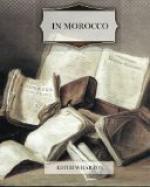Was ever shade so blue-black and delicious as that of the cork-tree near the spring where the donkey’s water-cans are being filled? Under its branches a black man in a blue shirt lies immovably sleeping in the dust. Close by women and children splash and chatter about the spring, and the dome of a saint’s tomb shines through lustreless leaves. The black man, the donkeys, the women and children, the saint’s dome, are all part of the inimitable Eastern scene in which inertia and agitation are so curiously combined, and a surface of shrill noise flickers over depths of such unfathomable silence.
The ruins of Chella belong to the purest period of Moroccan art. The tracery of the broken arches is all carved in stone or in glazed turquoise tiling, and the fragments of wall and vaulting have the firm elegance of a classic ruin. But what would even their beauty be without the leafy setting of the place? The “unimaginable touch of Time” gives Chella its peculiar charm: the aged fig-tree clamped in uptorn tiles and thrusting gouty arms between the arches; the garlanding of vines flung from column to column; the secret pool to which childless women are brought to bathe, and where the tree springing from a cleft of the steps is always hung with the bright bits of stuff which are the votive offerings of Africa.
The shade, the sound of springs, the terraced orange-garden with irises blooming along channels of running water, all this greenery and coolness in the hollow of a fierce red hill make Chella seem, to the traveller new to Africa, the very type and embodiment of its old contrasts of heat and freshness, of fire and languor. It is like a desert traveller’s dream in his last fever.
Yacoub-el-Mansour was the fourth of the great Almohad Sultans who, in the twelfth century, drove out the effete Almoravids, and swept their victorious armies from Marrakech to Tunis and from Tangier to Madrid. His grandfather, Abd-el-Moumen, had been occupied with conquest and civic administration. It was said of his rule that “he seized northern Africa to make order prevail there”; and in fact, out of a welter of wild tribes confusedly fighting and robbing he drew an empire firmly seated and securely governed, wherein caravans travelled from the Atlas to the Straits without fear of attack, and “a soldier wandering through the fields would not have dared to pluck an ear of wheat.”
[Illustration: From a photograph from the Service des Beaux-Arts au Maroc
Chella—ruins of mosque]
His grandson, the great El-Mansour, was a conqueror too; but where he conquered he planted the undying seed of beauty. The victor of Alarcos, the soldier who subdued the north of Spain, dreamed a great dream of art. His ambition was to bestow on his three capitals, Seville, Rabat and Marrakech, the three most beautiful towers the world had ever seen; and if the tower of Rabat had been completed, and that of Seville had not been injured by Spanish embellishments, his dream would have been realized.




